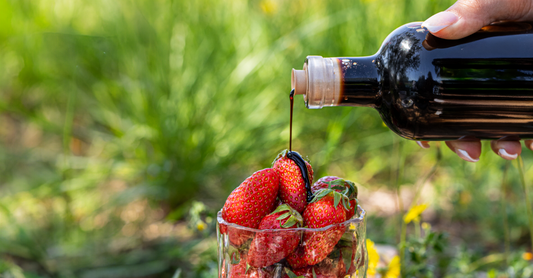At the heart of Italian gastronomy, balsamic vinegar of Modena stands out as a culinary treasure emblematic of the tradition and flavors of Italy. This condiment, both delicate and refined, is much more than a simple seasoning. Each drop is a celebration of artisanal quality, the art of aging and the complex aromas that develop over time. Produced mainly in the Modena region, this vinegar is a true ambassador of Mediterranean cuisine. Its production, which respects ancestral techniques, makes it a real value in the world of delicatessen.
What is Balsamic Vinegar of Modena?
Balsamic vinegar of Modena, also known by its Italian name Aceto Balsamico di Modena , is a rich and aromatic condiment made from mosto cotto , or cooked grape must. The ingredients are carefully selected and the product is then aged in barrels, sometimes for several decades. There are varieties for all tastes, from the traditional extra-aged balsamic with its sweet flavor and intense aroma, to the younger and more acidic versions. Balsamic vinegar of Modena is used in a multitude of recipes, bringing its unique touch, both in traditional Italian cuisine and in international gastronomy. Its conservation, a real art, is done in specific conditions to preserve its aroma and delicacy. The tradition of Modena vinegar making continues, offering gourmets around the world this treasure of Italian cuisine.
The production of balsamic vinegar of Modena
Balsamic vinegar of Modena, a true treasure of Italian gastronomic heritage, is an essential condiment with unique flavors. Its production, artisanal and rigorous, is a process that requires time, patience and traditional know-how inherited from previous generations. It is particularly appreciated for its refined aroma and sweet flavor, resulting from prolonged aging in barrels. The quality of this product is guaranteed by a protected designation of origin (DOP), which certifies its place of production in the Modena region, Italy.
Ingredients needed for production
The production of balsamic vinegar follows a very precise process, which begins with the selection of ingredients. Traditional balsamic vinegar of Modena is mainly made from mosto cotto, or cooked grape must. This base is obtained from local grape varieties, such as Lambrusco or Trebbiano, grown in the vineyards of the area. These vintages are harvested and then cooked to obtain a liquefied jam, which is then left to ferment and age to develop the characteristic aromas of balsamic vinegar.
The detailed manufacturing process
The process of making balsamic vinegar of Modena is an art in itself. The mosto cotto is first fermented in wooden vats, where it slowly transforms into vinegar. The mixture is then transferred to barrels of different types of wood, such as oak, chestnut or cherry, which will give it specific flavors and aromas. The barrels are stored in attics called vinegarries, where the vinegar ages for several years. This traditional culinary technique promotes the evaporation of water and the concentration of aromas. Finally, after an aging period that can last up to 25 years for extra-old balsamic vinegar, the vinegar is filtered and bottled. Each bottle thus represents the fruit of meticulous work and a rich culinary tradition, making balsamic vinegar of Modena a highly prized delicacy in Mediterranean cuisine.
The unique characteristics of balsamic vinegar of Modena
Balsamic vinegar of Modena is an Italian delicacy whose history and production techniques have been handed down from generation to generation. Made from Mosto Cotto, or cooked grape must, this precious condiment is aged in barrels of different types of wood to develop complex flavors and a refined aroma. The artisanal seasoning, which can be extra-old with an aging of up to 25 years, is a true expression of Italy's gastronomic tradition. Balsamic vinegar of Modena has a Protected Designation of Origin (DOP), which guarantees its quality and authenticity. Its careful conservation in the vinegar factory contributes to its mild flavor and intense aroma that make this regional treasure an indispensable element of the Mediterranean grocery store.
Differences with other vinegars
Compared to other vinegars, Balsamic Vinegar of Modena stands out for its unique production process and exceptional taste. Unlike wine vinegar, it is made from cooked grape must, not wine. In addition, its barrel aging gives it a mild flavor and a thick texture that is more like jam than traditional vinegar. Its complex aroma and sweet and tangy flavor make it a versatile condiment that can be used in both sweet and savory recipes in Italian cuisine.
Variations of Balsamic Vinegar of Modena
Balsamic vinegar of Modena comes in different varieties, each offering a unique taste experience. Traditional balsamic vinegar, produced using an ancestral method, is the most appreciated for its aromatic richness. For those who prefer a milder flavor, IGP balsamic vinegar offers an interesting alternative. Finally, aged balsamic vinegar is known for its syrupy texture and intense flavor, ideal for accompanying cheeses and desserts. Each variety, whether artisanal or industrial, reflects Italian culinary art and the attention paid to the quality of the ingredients and the production technique.
Use and tasting of balsamic vinegar of Modena
Balsamic vinegar of Modena is a treasure of Italian gastronomy. This condiment, as refined as it is delicious, is a true emblem of the Modena region. Its production, based on traditional techniques, gives it unique flavors that delight the most demanding palates. Rich in its exceptional quality, this vinegar with powerful aromas is the seasoning of choice for many recipes of Mediterranean cuisine.
How to use balsamic vinegar of Modena in cooking?
Using balsamic vinegar in cooking is an art that requires a certain amount of skill. Thanks to its mild flavor, this condiment goes perfectly with a multitude of dishes. It can be used as a seasoning for salads, grilled vegetables or even meats. For lovers of sweet and sour, it brings a touch of originality to jams or desserts. Don't forget that this artisanal product is very concentrated: a small amount is enough to enhance the flavor of your dishes. In Italian cuisine, it is also common to deglaze a pan with balsamic vinegar to extract the juices and give body to a sauce.
Tips for tasting balsamic vinegar of Modena
Tasting balsamic vinegar of Modena is a real pleasure for the senses. Its thick consistency, intense color and complex flavors make it a unique taste experience. To fully appreciate this condiment, it is recommended to consume it at room temperature. This way you can perceive all the nuances of its taste. Given its quality, it is best to savor it in small quantities, so as not to mask the flavors of the other ingredients. For an optimal tasting, you can place it on a piece of parmesan or combine it with extra virgin olive oil. It is a delicacy that pairs wonderfully with Mediterranean cuisine products.
Balsamic vinegar of Modena in Italian culture
Balsamic vinegar of Modena, an exceptional product in the world of Italian gastronomy, is a true culinary treasure. Produced in the Modena region, this condiment is a symbol of the richness and diversity of Italian gastronomic heritage. Made in an artisanal way , it comes from a long tradition of production and aging that gives it an unmatched quality and depth of taste. Thanks to its distinctive aroma and sweet flavor, this vinegar is a delicacy appreciated all over the world.
Balsamic vinegar of Modena in the Italian culinary tradition
Balsamic vinegar of Modena is an essential ingredient in many recipes of Italian cuisine. It is used as a seasoning in various dishes, from salads to grilled meats and roasted vegetables. Its unique flavor, both sweet and spicy, adds a refined touch to each recipe. In addition, its conservation in oak barrels for many years gives it a complexity and richness of flavors that distinguish it from other types of vinegar. Its protected designation of origin (DOP) guarantees its authenticity and quality, making this vinegar a true icon of Mediterranean cuisine.









 lucangeli.it
lucangeli.it